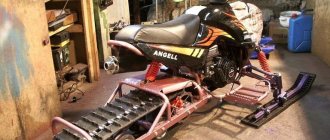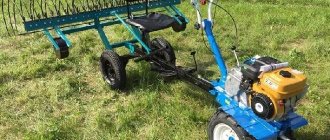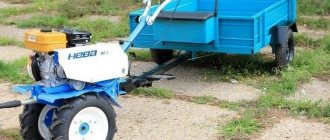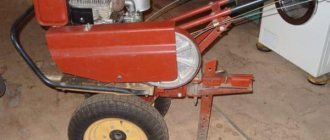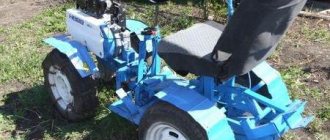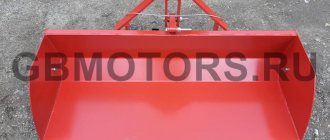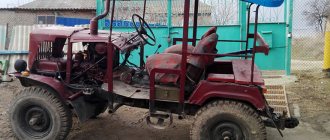The design of a mini excavator and its features.
To design a mini excavator, you need to make a diagram of your model, know the features of all elements, components, parts.
The design principle of a homemade mini excavator is similar to industrial technologies. If you have certain engineering skills, you can try to create an excavator design yourself. But it’s much easier to use the many ideas on the Internet forums.
When choosing designs, it should be noted that on foreign websites all measurements are indicated in inches, and they need to be converted to the domestic measurement system.
Having decided on the design, we make an estimate, without which we will not see all the nuances of a homemade excavator construction. In the estimate we indicate:
- Required Supplies
- Spare parts and parts
- Equipment for the production of spare parts
- Tools (availability or access)
- Approximate costs for manufacturing an excavator.
Having done all this, you can decide whether it is worth building it yourself or whether it is better to rent.
Necessary tools and consumables
To do the job efficiently, you need to prepare the following tools:
- Bulgarian.
- Drill.
- Ruler - triangle.
- Roulette.
- Marker.
- Adjustable wrench.
- Equipment for bending pipes.
- Hammer.
- Welding machine.
Consumables:
- Circles for turbine.
- Electrodes.
- Drill.
- Sandpaper.
- Dye.
- Tassels
- Solvent and primer.
Development history
The idea of creating an all-terrain vehicle belongs to a team of specialists who were engaged in delivering goods to the most remote areas of the country, including hard-to-reach places in the mountain tundra and swampy plains of virgin forests of the Komi Republic.
Employees of a trucking company who used domestic wheeled and tracked all-terrain vehicles of various brands and models to transport people and goods were able to verify from their own experience their low degree of reliability and poor off-road performance. In addition, they have compiled a large list of breakdowns that these types of vehicles are often susceptible to.
Based on the conclusions drawn and lengthy calculations, they were able to clearly determine what type of SUV is needed to work in the Far North.
Between 2010 and 2011 the company has developed 2 experimental models of the XPEN all-terrain vehicle, which received the appropriate quality certificates. Over the course of several years, the all-terrain vehicle was regularly modernized and improved, improving its technical characteristics. In January 2022, Rent LLC released a new swamp vehicle Zyryanin in various configurations.
Design features
Early versions of Arctic all-terrain vehicles, created in the 60s. last century, were based on the chassis of AT-T tracked vehicles. The design of the equipment used parts from the main medium tank T-54. Instead of a bonnet-type cab, a duralumin compartment was installed, in which there were seats for the driver and passengers. The increased area of the cabin made it possible to arrange seating areas and allocate space for auxiliary and sanitary facilities. The car was mass-produced under the designation “Kharkovchanka” until the 80s.
Since the potential for modernizing the old chassis had been exhausted, a task was issued to develop a new model. The Arctic all-terrain vehicle KamAZ, model 2022, with three drive axles, is equipped with an “old” model cabin with a modernized mantlet, and there is a habitable compartment behind it. The chassis consists of 2 halves connected to each other by a hinge. Thanks to the use of larger-diameter tires, it was possible to increase the ground clearance to 670 mm; the front part is equipped with a beveled bumper, allowing movement on snow or ice without the risk of damaging the cab.
The machine is equipped with original drive axles with a 3-speed gearbox.
Tires widened to 1000 mm do not allow the vehicle to travel on public roads without an escort (due to the width of the truck).
Important Design and technical characteristics of GAZelle Next board
Exterior and interior
Early versions of the Kharkovchanka Arctic vehicles have a habitable body that occupies the entire length of the tracked chassis. There are rectangular windows; above the navigator's workplace there is a spherical cap made of transparent plastic. The external surfaces are painted red-orange, allowing you to spot the all-terrain vehicle from a long distance in snow or blizzard conditions. The hood of the power unit (a modification of the V-2 tank diesel engine) is located inside the cabin, noise and exhaust gases penetrate into the cabin while driving.
The prototypes of Arctic all-terrain vehicles from KamAZ are painted bright blue, the head lighting equipment is partially recessed into the bumpers, and partially located on the front of the cab. To access the salon, hinged doors are used, and stairs with a bright orange plastic coating are installed. The car cabins have an adjustable driver's seat equipped with a shock absorber. The machines are distinguished by arched tires of increased diameter, which reduce the specific pressure on the ground.
Creating a wheel unit
First of all, it is advisable to equip standard engines with a speed reduction gearbox. This is explained by the fact that acceptable torque for both diesel and carburetor engines occurs at 80% of the maximum crankshaft rotation speed.
First you need to create a frame that will be located between the front and rear axles. For this task, profile pipes with a square cross-section are taken. Such components have a high degree of rigidity. When using heavy motor vehicles such as “Neva” or “MTZ”, they often perform rigid joining of the frame. Due to this, the all-terrain vehicle will be single-volume.
Another option is to use the so-called fracture (breakable frame), which provides great advantages when operating the unit in areas with rough terrain. In such a situation, the connection will be made through the kingpin. At the same time, both axles will be equipped with independent suspension.
To move through forests for hunting, it is possible to make a swamp vehicle based on a walk-behind tractor, equipped with a breaker frame. Compared to all-terrain vehicles with a strict frame, it is endowed with higher cross-country ability.
Rear axle and suspension system
The easiest way to make the rear axle is to use ready-made components from an old passenger car, for example, Moskvich 412. This is due to the insignificant weight of such elements, which makes it possible to practice them for the manufacture of an all-terrain vehicle. To ensure smooth travel, the suspension system is based on shock absorbers, which additionally reduces body vibration. In order to reduce fuel consumption and reduce resistance when traveling through areas with difficult driving conditions, it is advisable to make an independent suspension system for each rear wheel individually. To prevent a higher level of swaying, it is necessary to connect the frame to the rear axle, for this you should use hardened bolts, and to make the connections elastic, use rubber inserts.
What you need
Based on the basis on which the homemade all-terrain vehicle will be created, appropriate materials will be required. These include spare parts from old cars, motorcycles, and scooters.
Some parts will have to be purchased at special bases.
Some elements can be constructed from available materials (pipes, angles, hoses).
Tools for work
The set of tools for creating a homemade all-terrain vehicle is standard:
- Welding machine.
- Set of keys and screwdrivers.
- Bulgarian.
- Hammer.
- Pliers.
- Grinding machine or machine.
- Drill with screwdriver.
- Measuring instruments (level, tape measure, caliper).
- Pencil (chalk).
- Paints and varnishes.
- Protective equipment (gloves, goggles, welding helmet).
It is better to carry out work in specialized workshops where there is professional equipment.
Consumables
It all depends on the type of technique and basis. Materials required for the manufacture of an ATV based on the Ural-2 motorcycle:
- Modified frame, muffler, steering wheel with shaft, engine, gearbox, clutch, tank from the “donor”.
- Front wheels and shortened rear axle from VAZ-2101.
- Cardan shaft, constant velocity joint from Oka.
- Saddle, rear shock absorbers from a Ural motorcycle.
- The brake assembly and front suspension are from Zhiguli.
All-terrain vehicle based on the Urals
At the preparatory stage, drawings and a diagram of the future tricycle are being worked out. In the variant under consideration, chain transmission is not provided.
After choosing the final concept, they move on to turning the parts of the all-terrain vehicle.
Tools and Supplies
The frame from the Ural motorcycle, converted to accommodate the installation of a car rear axle, was chosen as the base. You will also need the following items:
- ICE type Lifan (6.5 hp);
- variator from a scooter;
- tarred fiberglass;
- moped generator;
- muffler with wide cross-section;
- metal corner 32 mm;
- tires out the Shishiga wheels;
- conveyor belt.
Important Tow trucks with a sliding platform and a manipulator crane
The instrument is traditional. You will need a lathe, yews, a set of keys, screwdrivers, a gas welding machine, and measuring devices.
Main stages of rework
The process of creating a three-wheeled all-terrain vehicle can be divided into several stages:
- Preparing a variator from a 4-stroke 150 cc scooter. This part is convenient because it is easy to adjust working and coupling speeds. These modifications are mounted on motors with power up to 14 hp.
- They begin to create the rear axle of the all-terrain vehicle, including preparing the site for the automobile bridge, manufacturing cones and flanges.
- The front fork is widened and adjusted to fit a wide rim.
- The seat is made of plastic, lubricating the prepared mold with wax and then laying fiberglass in several layers.
Making odorishi
On a light three-wheeled carakat they put “strippings” from the tires of a GAZ-66 or Ural (Lapot) car, as well as medium-sized tractors. The tires become lighter, while a new tread is cut onto the old rubber, which is responsible for reliable grip when driving on snow and mud.
It’s not difficult to make wheels for an all-terrain vehicle with your own hands. Process steps:
- Using a construction knife, a cut is made around the perimeter of the tire to remove the wire.
- Mark rectangles for the future tread and cut them out.
- The wire is removed with a hook and a hand winch or a screwdriver.
- The peeled rubber is peeled off.
- Remove unnecessary layers until the frame remains.
- The discs are welded to the plates, and the surfaces are sanded.
- Put the headband on the frame.
Engine and transmission
The wheeled all-terrain vehicle in question was equipped with a Lifan engine, modified for installation on a tricycle. A moped generator and a larger cross-section muffler were also installed. The standard carburetor did not perform well, which is why a tractor starter was installed.
The variator works great, in the 2nd range it makes it possible to slip and drift. In mode 4, the unit starts off smoothly, accelerates to 50 km/h, and at high speeds loses stable control. A unit from Honda City, Oka, Zhiguli is suitable as a transmission box. The gearbox is mounted on the vehicle frame and is coupled to the rear axle using a cardan drive.
Final improvements
At the final stage, the reliability of the assembly and the operation of all components are checked. The seat and body are painted, oil and fuel are added. If desired, fenders, mudguards, light and signal elements are mounted.
Manufacturing instructions
When assembling a 2x2 all-terrain vehicle, you must pay attention to ensure that all elements fit together.
If there is play in some components, the machine will fail in a short time. The power plant, fuel tank, drive, wheels are taken from a motorcycle or car.
Instructions:
- Weld a frame from thin-walled pipes or a quadrangular profile (use equipment for bending pipes, sheets of metal for additional fastening).
- Assemble the steering shaft from a pipe with a diameter of 20 mm and a wall thickness of 2.82 mm (there are 2 types of control: using a steering wheel from a car or a motorcycle).
- At the bottom, fix the limiter (sometimes they install suspensions from a motorcycle, front or rear).
- Attach the power unit from an air-cooled motorcycle.
- Place the battery to the engine ignition unit and secure it.
- Mount the rear drive (torque is transmitted using a chain passing through the shaft; it is installed on the gearbox pulley).
- With a chain drive, a sprocket is used on the rear wheel, and a gear is placed on the engine shaft.
- Install a disc brake on the shaft (in rear-wheel drive, the rear wheel brakes).
- Install wheels (for example, from UAZ-452).
- Fix the fuel tank in the planned location.
- Secure the pedal shift levers.
- Install the seat.
- Attach the headlight.
- Hide the wiring in the corrugation.
- Install a muffler.
The unit can be assembled relatively inexpensively using used spare parts from the domestic auto industry; it is better to install a new brake system. If travel will take place on paved roads, the design can be made lighter by installing a low-power engine. A large trunk made of pipes is sometimes installed on the frame.
Device
The two-seater all-terrain vehicle has an ATV-type landing. Otherwise, it is often called a “tandem”. The SUV is equipped with a powerful Lifan carburetor engine. The cylinder volume is 450 cm³, the engine power is 17 hp. The air cooling system protects the engine from overheating; it is important during long-term operation of the machine at low speed in the summer.
Thanks to its design, Vehor is easy to control. The five-speed transmission makes driving easy. The all-terrain vehicle can turn on the spot like a crawler tractor or through reverse.
The basic equipment of the vehicle includes:
- protective glass;
- electric starter;
- headlight and battery;
- hydraulic brakes;
- towbar;
- rear mirrors.
| Electric winch | 9,000 rub. |
| Marker lights | 1,000 rub. |
| Sleigh-drag | 5,000 rub. |
| Protective case | 6,000 rub. |
| Case-bag | 9,000 rub. |
You can buy a trailer for cargo: a tipper type, with off-road tires or folding sides. There are options with a load capacity of 300 kg.
Important Review of the best Pubert walk-behind tractors made in France
General technical specifications
Parameters of the Samson tricycle, made on the basis of the IZH-Jupiter 5 motorcycle:
- front/rear brake - manual hydraulic disc/foot drum;
- overall dimensions - 3.55/2.26/1.58 m;
- wheelbase - 1.6 m;
- total weight - 470 kg;
- speed - 40 km/h;
- fuel consumption - 9 l/100 km;
- transmission - chain drive with transfer case;
- front/rear suspension - extended telescopic fork/pendulum with adjustable shock absorbers;
- engine - gasoline engine with 2 cylinders with a volume of 347 cc. cm (24.5 hp).
How to make a homemade wheeled all-terrain vehicle
Figure 1. All-terrain vehicle diagram.
It is recommended to equip the unit with a device - a gearbox, which reduces engine speed. The two types of units have optimal torque performance when the crankshaft rotation speed reaches 85% of the maximum. Expert opinion
Rukin Daniil
Snowmobile specialist "Buran". I go fishing in my free time.
Ask a Question
The engine must have a built-in forced system. cooling. When driving at low speed, the oncoming flow will not be enough to maintain optimal thermal conditions.
All-terrain vehicle frame
Figure 2. Drawing of the fracture frame.
Between the two axles, front and rear, you need a frame. To create it, it is better to use profile pipes of different types of sections, which provide greater rigidity compared to rolled corners of the same mass. The joining of the parts of the wheeled all-terrain vehicle frame can be rigid, then it will be formed in one format. When using heavy Neva walk-behind tractors, it should be noted that this design option will be the best.
They create a breaking frame for places with a complex profile. In this case, the connection is made through a king pin. The front and rear axles are equipped with independent suspension. Specialists produce these all-terrain vehicles based on walk-behind tractors and Ugra.
In order to hunt and fish, you can make a wheeled all-terrain vehicle with a breakable frame; its maneuverability will be better compared to a rigid design.
Description of the vehicle
An all-terrain vehicle is a vehicle for off-road driving. The most popular variety in this segment is ATVs, but there are modifications with 3 and 2 wheels.
Based on operational capabilities, there are 2 groups of all-terrain vehicles. Category 1 includes utilitarian models designed for household needs and exciting walks. With such a unit you can go into the forest or go fishing in areas where even a jeep cannot pass. Sports versions are used for off-road racing or extreme driving.

